Perhaps American Pro Football’s most popular offensive formation over the past 50 years has been the so-called “I” formation. The Quarterback lines up behind the Center, with the Full-back and the Tail-back directly behind him in the shape of the letter “I”.
It is popular because of its versatility. Either of the running backs can run right or left with equal facility, or they can split to either side of the pitch on passing routes.
If the defence starts to over-commit to running plays, the QB can use ‘play-action’ – fake a running play to one of the backs but instead, keeping the ball and passing downfield.
An extreme example of the “I’s” flexibility can be viewed on this play from a College Football game between Michigan and Wisconsin:
https://www.youtube.com/watch?v=b1ooCns5cCo
All the 10 offensive players (bar the QB) start in an extended “I” caterpillar before breaking into a more conventional three-man “I” (QB-FB-TB) just before the snap. The panic of the defensive side of the ball is self-evident!
The theory behind the “I” formation has already translated to rugby in local circumstances. It is regularly used by attacking sides from scrums to disguise their intentions. In his Rugby Site series on Support Play, ‘The Professor’ Wayne Smith recommends the ‘L’ shape in realignment: support players consciously making the effort to drop back, across and directly in behind the ball-carrier; ‘slipstreaming’ for maximum flexibility – able to pop out on to short passes going left or right and mask attacking decisions until the last moment.
Italy are not generally known for their attacking innovation, but under their ex-All Black full-back and head coach Kieran Crowley they have adapted the “I” for use in phase play. Here is a relatively straightforward example from the November game between the Azzurri and the Wallabies in Florence:
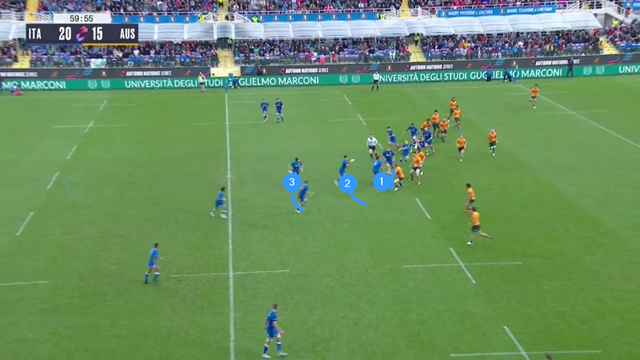
The depth and flexibility of the formation, with three attacking players aligning directly behind one another, creates uncertainty for the defenders. It is hard to read, hard to get to the deep-lying options without disrupting the integrity of a single line of defence, hard to focus on the players in the “I” with another two attackers outside them.
Italy scored their game-deciding try from an I-formation containing one distributor (#10 Tommaso Allan) and two backs with superior evasive skill-sets, #11 Monty Ioane and #15 Ange Capuozzo:
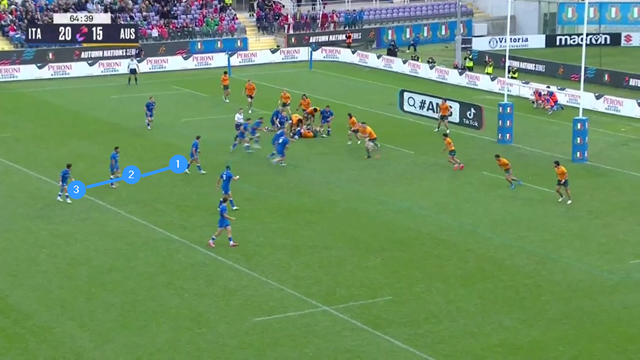
This is the optimal arrangement with Allan ahead of the play at “1”, and two potent strikers behind him – Ioane at “2” and Capuozzo at “3”. In the first instance, the Australian inside defence opposite has to stay honest and commit to the Italian forward pod in front of them.
This is how the scoring play unfolded:
Each of the Wallaby defenders is drawn on to the attacker in front of them, then beaten by the steep angles of support coming from behind the ball-carrier, as the “I” flattens out towards the right side-line.
The attacking achievement looks even clearer and more impressive from the angle behind the posts:
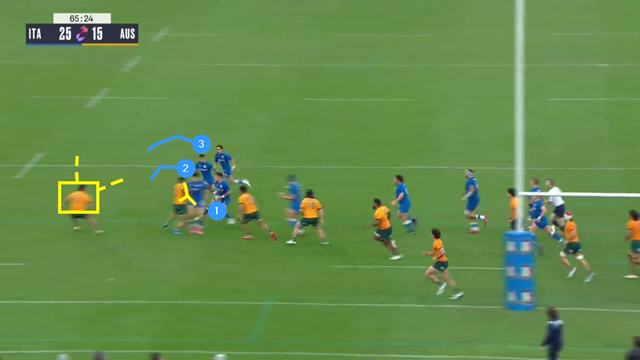
The Australian #13 Len Ikitau does his best to take care of both the front decoy (Italy #12 Luca Morisi) and Allan as the first passer behind him, but it is a hopeless task. Once the ball gets beyond Allan, the next defender (Australian #11 Tom Wright) is faced by a two-on-one coming from deep: if he sticks on Ioane the wing will pass to Capuozzo, if he moves on to the Azzurri full-back Ioane can keep the ball and break the line himself. In the event he chooses option one, but it is indeed Hobson’s choice.
Italy demonstrated the versatility of their “I” formation in the recent Six Nations game against France in Rome:
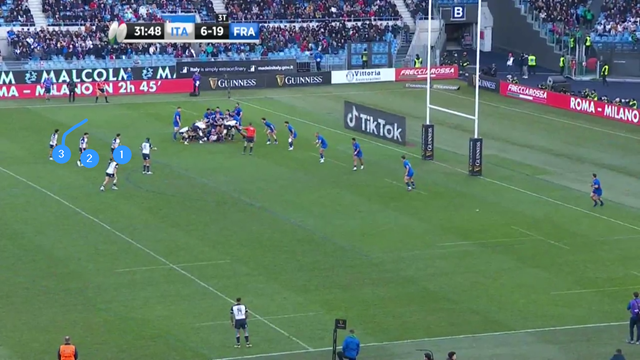
Once again, the Italy 10, 11 and 15 are standing in the “I”, one behind another in a line. The French defence to the open-side of the field is well-organised, so on this occasion Capuozzo breaks back to the short-side once the maul has ground to a halt with penalty advantage to the home side:
All of the French forwards have condensed on the right, or short-side of the drive, and France’s right wing Damian Penaud has moved across to become the first back-line defender on the other side. When Capuozzo makes his move, he automatically creates a mismatch with the French number 8 forward Greg Alldritt.
Summary
The ”I” formation has been around for a long time in American Football, and remains one of the staple formations in a balanced offence. Rugby has imitated that balance and flexibility in support play and from scrums, now it is doing it in phase play. Italy have shown they are good enough to be at the cutting edge, by using their #10 and two strong, elusive striker-runners behind him in a single vertical line of attack, masking the direction and purpose of their thrust until the very last moment.
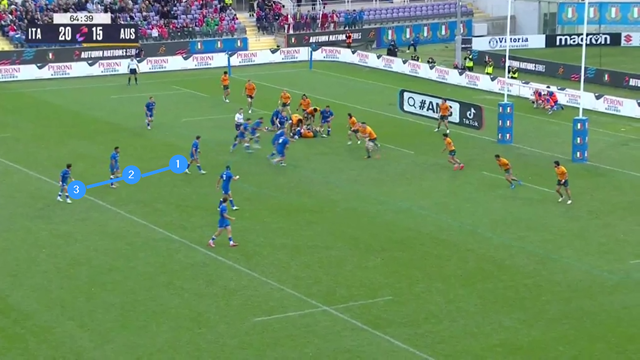











.jpg)

.jpg)







